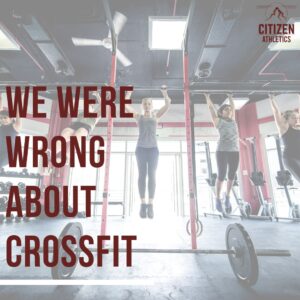There is a lot of conflicting information in the rehab and strength and conditioning world. Look no further than the comments section on a viral post or video, and you can’t miss the dissension. Sometimes it’s even hard to find conclusive information in the research!
And for people who don’t spend their lives immersed in this field, it’s downright confusing. Information moves fast and research is constantly forcing us to humble ourselves, evolve, and be willing to be wrong.
I’m here to tell that if you’ve ever given advice to someone, you were probably wrong. And if you’ve ever received advice, it might have been wrong. And if you got advice from me 5 years ago, it was probably wrong too!
Although a healthy discourse is essential to growth, problems arise when conflicting information leaves people confused. It doesn’t help our fitness community reach a larger audience, get more people exercising, or positively influence our clients, athletes, and patients. I’m personally just sick and tired of hearing people say “but my therapist/trainer said you *have* to do this…” There are very few absolutes, and even less steadfast rules. Do you, bro.
Let’s look at crossfit.
Boy, were we wrong. Everyone said crossfit was a travesty. “Look at that horrible form!” “The olympic lifts are supposed to be 1 rep!” …I’ve heard all the arguments and I’ve made most of them myself. For years the biggest buzz question was, “what do you think of crossfit?” And now, no one even asks that because crossfit is obviously here to stay. And it’s been awesome for our industry.
Crossfit has put more barbells in peoples hands than powerlifting and olympic lifting ever did.
Weightlifting, training, and physical exertion have never been more mainstream. Everyone in the industry has benefited from crossfit: it’s helped spread the gospel of training. I’d bet that you have more friends and family squatting than you did 5 years ago… and it’s not all because of you.
One quick little disclaimer- I’m not condoning poor and dangerous form, and I suggest you have a solid training base before attempting repeated high effort lifts in states of fatigue.
What we failed to think about when we stuck up our noses to crossfit was the problems it was addressing head on- not enough people resistance train or even know how to, and big commercial gyms full of machines have trouble keeping people’s interest.
Crossfit was the solution- a group and camaraderie based resistance training and cardio workout with a low barrier to entry and low business startup cost. The rest was history. If we had looked at the bigger picture, and not our ego’s, the strength and therapy world might have embraced crossfit sooner. Sure, it’s not what we would suggest for all of our clients, but are there any universal workouts that are OK for everyone
Moreover, “crossfit” has evolved.
Crossfit of 2020 isn’t the same thing as the crossfit of 2010 that got so many fitness industry snobs up in arms. Many crossfit gym will tell you, “well, we’re not real crossfit.” They start their clients off with introductory training to get them up to speed, and their coaches pay attention to the individual needs of their class attendees. This was inevitable, as gyms can’t survive if their patrons can’t handle the workload and drop out due to injury.
Over the past decade I have watched the fitness and therapy industry turn into an ego-driven and opinionated battlefield. Our practices are driven by us as individuals making decisions on what our clients and patients should do, and we’re usually right. This success contributes to our confirmation bias that we are always doing the right thing. Sometimes we forget, all training works.
While we strive to be science and evidence based in our practices and clinical decision making, there is a lot of wiggle room in the application of basic principles. Although there is a lot that we agree on, there will never be full consensus in this industry.
There is no such thing as one perfect workout, one perfect answer, or one solution; and that’s what makes it fun. What is important for us to recognize is that our sole decision is not the only right one. And while we hate to admit, there’s a lot more that we agree on than disagree on.
So if you want to overhead press, static stretch, olympic lift, do cuff exercises, cue knees out on squats, false grip bench, foam roll for an hour everyday, deadlift in running shoes, do crunches off the rafters like Rocky Balboa, or do an entire workout consisting of nothing but muscle-ups, go for it. Just remember that your right way to find success in fitness is not the only right way.
-Teddy


